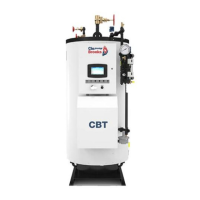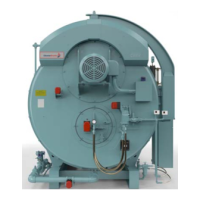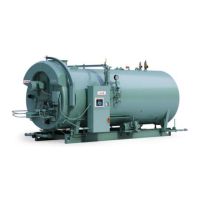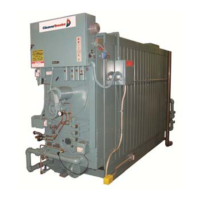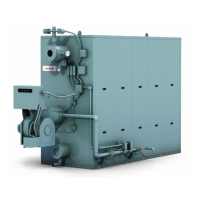51 750-265
FAULT HANDLING
Lockouts and Alerts
The CB Falcon implements two kinds of faults: lockouts and
alerts.
A list of fault codes with possible troubleshooting tips is
provided in Table 45 on page 99.
A list of alerts is provided in Table 39 on page 89.
LOCKOUT
• A lockout causes the boiler control to shutdown and
requires manual or remote reset to clear the lockout.
• Always causes alarm contacts to close.
• Logged in lockout history.
ALERT
• Every other kind of problem that isn't a lockout is an alert.
Examples include boiler control abnormal holds, LL master
problems, faults from non-safety functions, etc. The Falcon
will include alerts for all abnormal events that are
relevant to an operator or end user.
• When an alert occurs, it is a one-time event. Alerts never
require manual intervention to reset them; that is, if the
alert clears up, then normal operation will continue. An
alert is not a condition, it is an event. The cause of the alert
may be a condition, e.g. something that is causing an
abnormal hold, but the alert itself in this case is a
momentary event generated upon entry to that condition.
• Whether the alarm contact closes or not is programmable
for each alert by the OEM.
• Alerts are logged in a 15-item volatile alert history sorted in
chronological order. Only one instance of each alert fault
code occurs in the history, corresponding to the most
recent occurrence of the alert.
Alarms for Alerts
The Alarm Parameter Control Block (see the section above)
determines which alerts will cause an alarm (by closing the
alarm contacts) and which will be reported silently.
Thus an alarm might be on because of a lockout or an alert. If
the cause is a lockout then the alarm contacts remain close
until the lockout is cleared. However, for alarms due to alerts
(which may recur) the alarm may be silenced for a period of
time (0–600 minutes) by specifying it in the Alarm Silence
Time parameter.
Sensor Signal Conditioning
The analog sensors signal includes filtering to reduce the
effect of noise and spurious read events. This filter includes
averaging to smooth sensor output and reject occasional
spurious values to prevent them from affecting the average.
The Falcon subsystems implement a startup delay to allow
sensors to be read multiple times before they are used, to
prime the filtering.
Sensors won’t cause a fault condition unless the value is
requested for control purposes. Thus it is not a fault for a
sensor to be absent or otherwise non-operational unless it is
used for something.
If its value is requested and a sensor fault exists, then an alert
condition is triggered by the requestor in response to the fault
status, unless this is either a normal operating condition (e.g.,
the DHW sensor used as a switch) or causes a lockout (e.g., a
failed high limit sensor).
Safety sensors include the comparison of redundant sensors.
If a safety sensor mismatch occurs this is reported to the
caller as a fault (which will cause the operator to take an
appropriate action).
Sensor faults will include:
• out-of-range: low
• out-of-range: high—distinguishing low vs. high is
important when sensor inputs are being used as digital on/
off inputs; in this case these out-of-range values are not
faults.
• mismatch—applies to safety sensors, where two sensors
are compared.
Sensor fault status will include hysteresis to prevent non-
persistent events from affecting fault status. This hysteresis
will provide a failed sensor response less than 1 second.
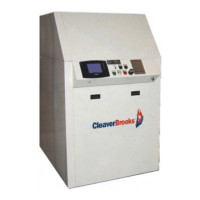
